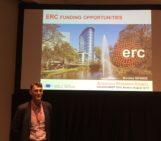Finding funding to support your research is always a challenge, but never more so than when you’ve not done it before. During the EGU 2014 General Assembly, Grant Allen gave an excellent short course for early-career researchers on getting to grips with grant applications. His fantastically appropriate name aside, we couldn’t have asked for a better person to do the job: bursting with tips from start to finish, not a second of his course was worth missing! Here’s a summary of his take-home points…
The first thing to do, as with any endeavour, is to plan. And plan to win. Think about what you’re going to do if you get that proposal accepted and, importantly, whether you would have time to do the research if it is.
To be successful, you need to build on your previous work with something that is more than just an extension. Adding an extra room to your scientific house is not enough – break into the field next door and build on your work with a new, topical and ambitious venture. Better yet, go beyond the field next door – funders like to see you tap into the worldwide research network. Tell them you’re going to lay foundations at other institutes.

Build on your previous work, but think big – and be ambitious! (Credit: Jon Grant)
Grant proposals need to be challenging, but also achievable – otherwise they won’t be funded. This doesn’t mean that you have to make it a low-cost project (though this can also be a good thing). What’s important is ensuring you will have enough resources to do the job. Don’t under-resource it, or it won’t get funded.
It’s also important to demonstrate the potential impact of your project. This part of the application is likely to become increasingly important, so take care to consider the societal, economical, environmental and cultural benefits of your work. To get a good score for impact in your proposal, say what impact will be delivered, when and how. Be specific.

Right on the on money. (Credit: Flickr user 401(k))
For a fellowship application, you also need to show that an investment in you is worthwhile: give the funders evidence of a great track record, one that showcases your potential. These applications are more likely to give greater weight to your academic excellence than the potential impact of your work.
Putting pen to paper – writing pointers
Keep it simple. Reviewers do their job voluntarily, so make sure your proposal is accessible to non-specialists. Take the reader on a journey from the general geosciences and funnel them towards something more specific, starting with the bigger picture before honing in on the project details and the plan for the work ahead. Allen recommends splitting the proposal like so: with one third on the scientific motivation, and two thirds on the work plan.
Make a proposal look good. Nobody wants to see 8 pages of text! When you’re finished, find a willing volunteer, give them a few beers, or put them in a bad mood, and ask them to check it over to see if they would fund your project. Account for the spectrum of reviewers your carefully crafted proposal might encounter. Asking friends or colleagues to take a look can also weed out any typos you might have missed, as well as any sentences that are unclear.

Putting pen to paper. (Credit: Flickr user Witheyes)
In the dragon’s den – what to do when meeting the panel
In the panel interview, you’ll start with a 10 minute summary of your project – this is your chance to shine. During your presentation you are in control: you can say what you like (within reason, of course), and really show off your project and its potential. Aim to have one take home message per slide, following the same narrative as your proposal.
A sobering note – what are your chances?
Despite all this good advice, your first proposal is unlikely to get funded. The success rate is 15-20% across Europe and you really have to stand out to succeed. With that though, comes a little reassurance: don’t be disheartened if your proposal does get rejected, you know the success rate is low. Instead, take that experience and learn from it so you can make your next proposal even better.
One thing you’ll often need to include is a letter of support. Look around your lab to see how many people are in your team and think about how many letters of support your group leader will be asked to write. Then think back to that success rate. If 80-85% of proposals are rejected, that’s a lot of letters. Allen suggests drafting a letter of support for your supervisor to check, change and sign – an unconventional approach, but when you consider how great the average academic workload is, you can see how they’d appreciate it.
Be confident, ambitious, bold, concise, organised and pay attention to detail. Budgets and planning are the boring constants of any grant proposal, but your science and your track record is something that can really shine, make sure you let it!
By Sara Mynott, EGU Communications Officer





Pingback: Finding funding: a rough guide to getting your ...